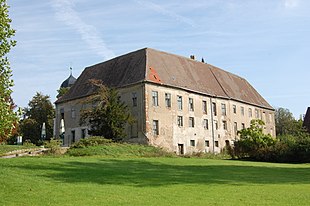Dieskau Castle
The Dieskau Castle is a castle in the municipality Kabelsketal belonging village Dieskau in Saxony-Anhalt .
location
It is located on the western edge of the village in the meadow landscape on the north bank of the Reide . The castle is surrounded by the Dieskau Castle Park, which was laid out in 1778 . St. Anne's Church, built in 1728, is located directly north of the castle .
History and architecture
In 1225 a knight Otto was enfeoffed with the moated castle in Dieskau and named himself after this von Dieskau .
Today's castle was built in the late Renaissance style in place of the moated castle from the Middle Ages . Construction phases from the second half of the 15th century could be verified. The builders of the castle were Hieronymus von Dieskau (1501–1567) and Hieronymus von Dieskau the Younger (1565–1625). In 1622 it was partially renovated and rebuilt. The current appearance goes back to a renovation from 1878, which took place in the style of the neo-Renaissance .
The castle has four three-storey wings that are grouped around a courtyard with a rectangular floor plan. The north wing is only half the length of the rest and goes back to the second half of the 15th century. The ground floor was built massive, above it two half-timbered floors . In front of the eastern wing is a polygonal stair tower . The core of the east wing was built as early as 1458 as a late Gothic post structure, also with a solid ground floor and two storeys made of half-timbered structures. In the south-western corner of the courtyard there is also a stair tower that was built in the 19th century. In the south wing, a walled-up portal with an inscription plaque can be seen, which dates from the 17th century. The south wing was built in two phases until 1624. The west wing was built in the 17th century. The castle church St. Anna also belongs to the castle ensemble .
In the south wing on the first floor there is a room with a coffered ceiling , created between 1622 and 1624, with religious motifs and moralizing texts. Twelve of the original eighteen cassette fields have been preserved. It is one of the oldest blankets of this type in Saxony-Anhalt. A plank room from the late Middle Ages has been preserved in the east wing . There are wall paintings in the west wing and the classical ballroom on the first floor .
After the Dieskau branch of Dieskau died out in 1744, the chief magistrate Johann Friedrich Alburg (1683–1763) bought the property in 1746. His daughter married Carl Christoph Hoffmann (1735-1801), who was ennobled in 1784 and appointed Chancellor of the University of Halle in 1786. From 1778 to 1784 he had an English landscape garden laid out by Johann George Gottlieb Schoch based on the model of the Wörlitz Park . He had the ballroom decorated by Carl Gotthard Langhans , the builder of the Brandenburg Gate in Berlin, who also built the Halle observatory on Hoffmann's behalf .
In 1853, Hoffmann's heirs sold the castle to the Magdeburg merchant Müller, who gave it to his nephew Otto von Bülow (1812–1871). In the possession of the von Bülow family until the expropriation in 1945 , Dieskau Castle served as a school from 1950 to the early 1980s. Then the Free German Youth (FDJ) began to convert it into a training center. After 1990 the municipality sold the castle to the restorer Thymo von Rauchhaupt , who began the renovation and secured the shell from deterioration. However, large parts of the castle are still in need of restoration. There are rooms on the ground floor of the castle that can be rented for various festivities (e.g. family celebrations). Year-round music events and an open-air cinema in the summer months enrich the cultural offerings of the Kabelsketal community.
The adjoining 67 hectare castle park Dieskau , laid out in 1778 based on the model of the Dessau-Wörlitz Garden Kingdom, is maintained by an association under the supervision of the State Office for Monument Preservation.
See also
literature
- Georg Dehio : Handbook of the German art monuments. Saxony-Anhalt II: Dessau and Halle administrative districts. Deutscher Kunstverlag , Munich Berlin 1999, ISBN 3-422-03065-4 , p. 153 f.
- Irene Roch-Lemmer: mansions in the area of Halle . In: Castles and palaces in Saxony-Anhalt . Announcements from the Saxony-Anhalt regional group of the German Castle Association, Issue 7, Halle (Saale) 1998. pp. 177–183.
- Matthias Prasse : Dieskau Castle and the von Rauchhaupt family . Herrenhaus-Kultur-Verlag, Coswig 2016, ISBN 978-3-9817309-2-0
Web links
Coordinates: 51 ° 26 ′ 4.7 ″ N , 12 ° 2 ′ 18.5 ″ E










